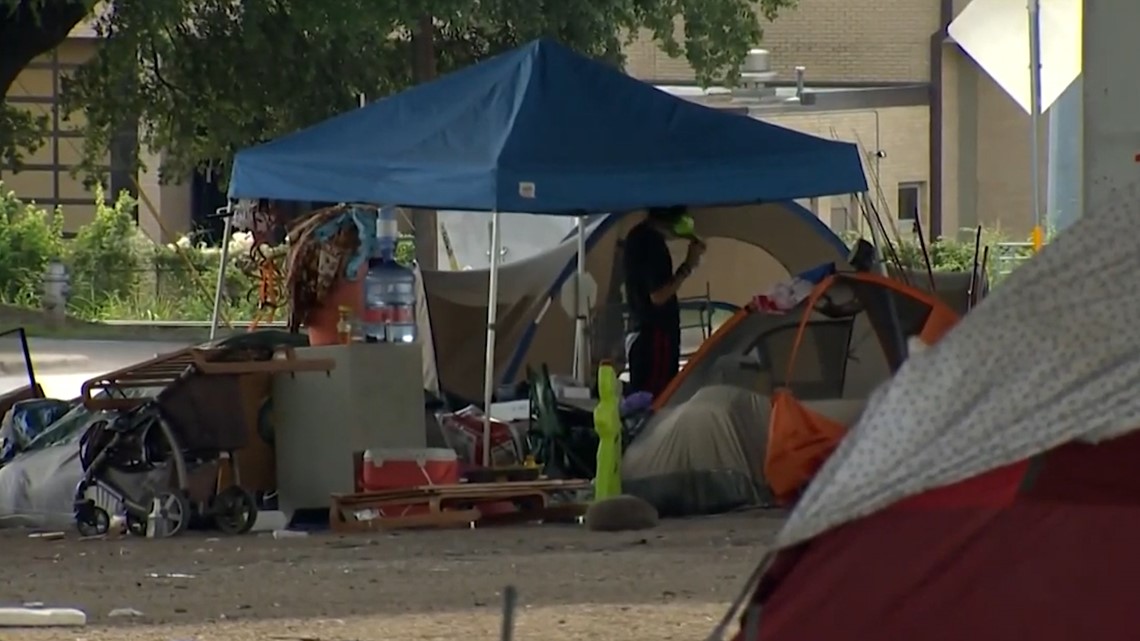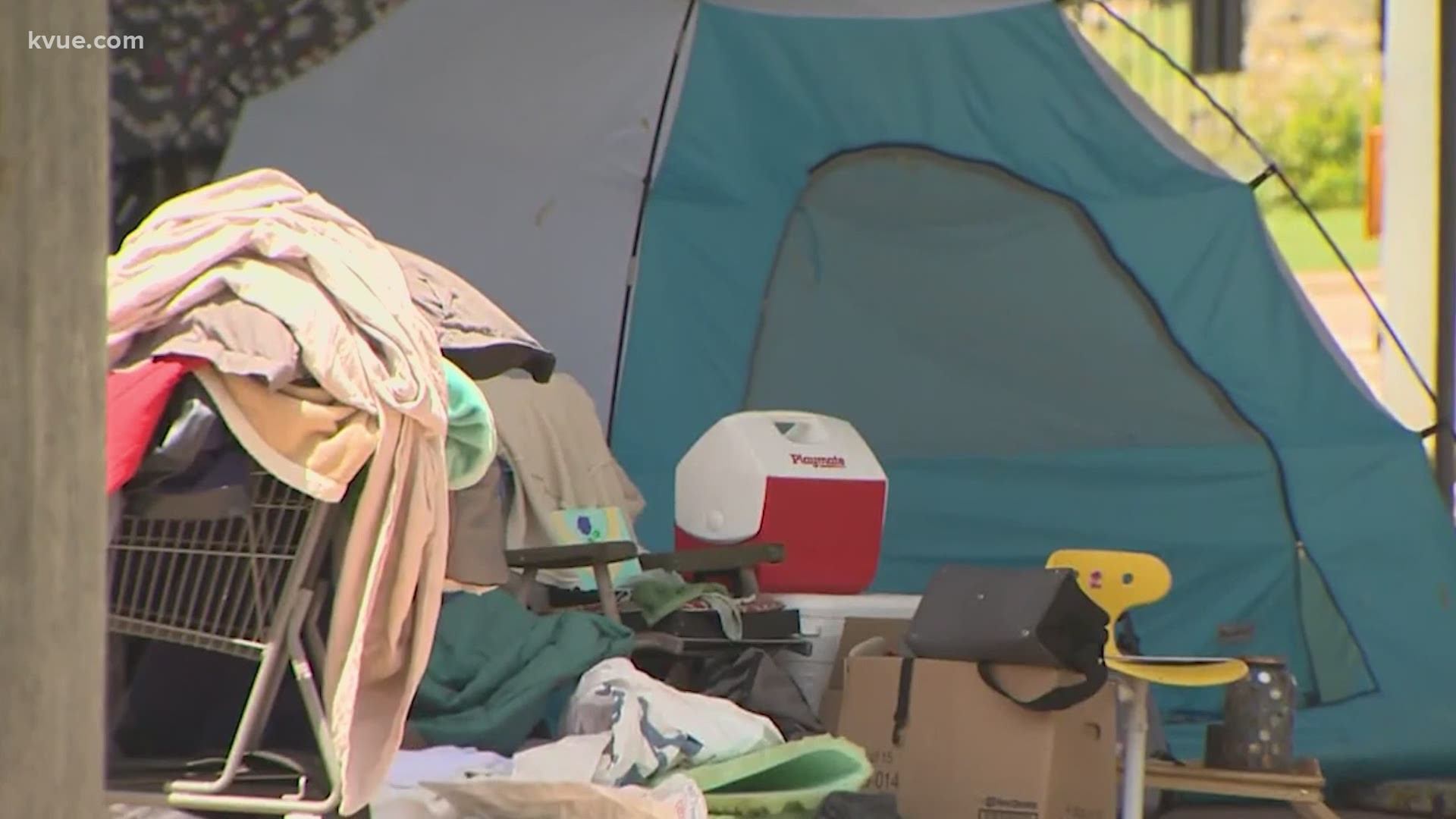AUSTIN, Texas — Homelessness in Austin isn't a new headline. But some have speculated whether or not the city's homeless population is growing due to the COVID-19 pandemic.
There has also been recent discussion about the number of calls first responders are taking related to homelessness – something that was brought up at the Public Safety Committee's meeting Monday.
Questioning homeless population growth during the pandemic
Results from the 2020 Point in Time count (PIT) released back in May showed an 11% increase in people experiencing homelessness in Austin-Travis County.
But Chris Davis, the communications manager for the Ending Community Homelessness Coalition (ECHO), told KVUE via email Tuesday that, at this point, they don't have evidence that the number of people experiencing homelessness is increasing due to the pandemic.
"It's true we saw an increase in the PIT Count this year, but it's important to distinguish between that number and the number of people experiencing homelessness. The PIT Count measures as many people as volunteers can count over the course of a few hours," Davis said. "We are planning for an increase due to the economic effects, especially if the Senate continues to refuse to pass provisions of the HEROES Act that would provide much-needed rental assistance to keep people stably housed. But we don't have data to show an increase at this point. We are and will be tracking that in the coming months."
Davis added that the population might seem like it's increasing based on the number of encampments that the public sees.
He said that outreach teams started handing out tents to people toward the beginning of the pandemic so they'd have a place to self-isolate and social distance. There are also not as many cleanups happening due to CDC guidance that recommended not cleaning out encampments.
"These measures help to keep people experiencing homelessness safe and healthy during a pandemic, and we also believe they're contributing to a perceived increase in encampments," Davis said.
On the other hand, Mark Hilbelink, the director for the Sunrise Homeless Navigation Center, said he believes the population could have increased, but not drastically.
He told KVUE he thinks it's a combination of three things, the first being "ordinance visibility."
"After the changes, the ordinance, the same amount of homeless people just appeared to be much bigger because they were much more visible. Each individual person in a tent makes the entire population seem much bigger. So, I think the visibility was a significant chunk," Hilbelink said.
The second factor is that there was a movement of people experiencing homelessness around the city limits due to the pandemic, including moving from downtown to areas like the U.S. 183 corridor in North Austin and parts of South Austin.
"Because downtown was more or less a ghost town and most of the homeless folks that are down there were down there because of the services provided and because they had good panhandling opportunities. The panhandling opportunities ... significantly reduced, and a lot of the service providers were not open," Hilbelink said. "I think we're starting to see the first wave of what we can expect will be a much larger wave of homelessness probably in a few months as whenever the eviction freeze is off."
Hilbelink added that at Sunrise, which hands out food and clothes and provides other services to the homeless, they were seeing on average 200 people a day pre-pandemic. At the height of the pandemic so far, they were seeing 600 people on average. And more recently, they are back to 300 people a day on average.


Public safety response and homelessness
Homelessness in Austin was discussed for hours at Monday's Public Safety Committee meeting.
Among other things, Joe Chacon with APD presented information using data from APD's research and planning division to show the number of crimes or criminal activity that involved individuals experiencing homelessness either as a suspect or a victim from January through September of 2020, in comparison to that time frame in 2019.
"And what we saw is that there really has not been any big change in either direction, either a rise or a fall in those numbers. Really, largely, they remain flat," Chacon said. "And, as in years past, we continue to see individuals experiencing homelessness disproportionately overrepresented in overall criminal activity in our city."
To mitigate that, Chacon said APD is partnering on a number of different fronts for outreach, including the Downtown Austin Community Court to provide alternative outcomes to incarceration wherever appropriate.
Andy Hoffmeister with ATCEMS went over the available data on 911 response specific to EMS and not related to the Homeless Outreach Street Team.
Hoffmeister explained that the numbers are pretty flat when comparing 2018-2019 to 2019-2020.
"When I compared the two years, the same areas within the city are – remain impacted about the same," Hoffmeister said. "The downtown area and the 78701 ZIP code certainly has the largest portion of incidents involving persons experiencing homelessness with a few others in the east, southeast and in north-central areas, northeast parts of town.
City, State and other nonprofits stepping in
KVUE has reported on multiple things that the City of Austin and the State of Texas have done to assist the homeless population, including the City leasing hotels to house the homeless during the pandemic and the State issuing a plot of land specifically for homeless encampments in southeast Travis County not far from the airport.
According to a City spokesperson, there are five ProLodges still being used with 312 people staying in them. Forty-two have moved into permanent housing, and 25 have returned to the street.
Recently, the nonprofit The Other Ones Foundation (TOOF) moved its headquarters to the State-issued homeless camp to better serve people experiencing homelessness. A total of 150 people stay there.
Among other things, TOOF brought in mobile hygiene clinics supplied with showers and hygiene products and a headquarters with a charging station. Organizers are also in the process of building a kitchen for open use.
As for ECHO, Davis explained that they're part of a large group of organizations responding to the pandemic, which includes collecting hygiene and other safety supplies for partners to hand out.
"There's also a ton of other collaboration happening. The City of Austin-led Eating Apart Together (EAT) initiative just surpassed 500,000 meals delivered to people experiencing homelessness in encampments all over Travis County since the start of the pandemic," Davis said.
Hilbelink said the Sunrise Homeless Navigation Center continues to serve food and clothing to the homeless regularly.
PEOPLE ARE ALSO READING:

